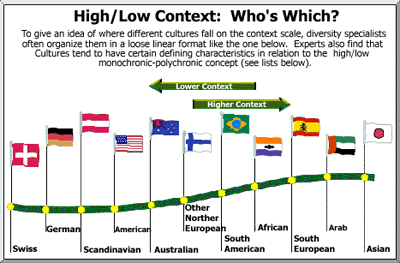Imagine walking into a business meeting in a foreign country. You’re eager to impress, but you find yourself struggling to decipher the unspoken cues. Your colleagues seem to be communicating in a way you can’t quite understand, leaving you feeling confused and out of place. This is a common experience for many who navigate different cultural landscapes. Understanding the concept of high-context and low-context cultures can shed light on these differences and help navigate such scenarios with greater ease.

Image: www.slideserve.com
This concept, first introduced by anthropologist Edward T. Hall in the 1970s, highlights how cultures communicate and interpret information differently. While the spoken word plays a role, it’s often the unspoken, contextual cues that truly shape the meaning of communication. Let’s explore the fascinating world of high-context and low-context cultures and unpack their nuances.
High-Context vs. Low-Context Cultures: A Deep Dive
High-context cultures place a strong emphasis on nonverbal cues, shared history, and implicit understanding. In these societies, communication is often subtle and indirect, with a great deal of information conveyed through body language, tone of voice, and shared cultural knowledge. Think of it as a tapestry where meaning is woven into the fabric of shared experiences and understanding.
Consider an example: In a high-context culture, a simple gesture like a raised eyebrow might carry significant meaning. This subtle cue could convey disapproval, skepticism, or even humor, depending on the context and shared history between the individuals involved. The meaning is not explicitly stated but rather interpreted based on a collective understanding.
Low-Context Cultures: A Direct Approach
In contrast, low-context cultures rely heavily on explicit communication. Information is conveyed directly through spoken words, with little room for ambiguity or interpretation. These cultures emphasize clear, concise language, and often prioritize written documentation as a means of establishing shared understanding. In a low-context setting, a direct answer to a question is expected, and silence is often viewed as a lack of engagement or understanding.
Take, for instance, a business negotiation. In a low-context culture, the terms of the agreement would be clearly outlined in a contract, leaving little room for misinterpretation. This emphasis on explicit communication ensures that everyone is on the same page and minimizes the potential for misunderstandings.
Key Cultural Differences
The distinction between high-context and low-context cultures extends beyond communication styles. It influences various aspects of societal behavior, including:
- Decision-making: High-context cultures often rely on consensus-building and collective decision-making, whereas low-context cultures tend to prioritize individual contributions and efficiency.
- Time perception: High-context cultures often have a more flexible perception of time, focusing on relationships and building trust. Low-context cultures often prioritize punctuality and adhering to schedules.
- Personal space: High-context cultures tend to have smaller personal space bubbles, with physical contact and proximity viewed as expressions of intimacy. Low-context cultures generally value more personal space and may feel uncomfortable with close physical proximity.
- Conflict resolution: High-context cultures often prioritize harmony and maintaining relationships, opting for indirect negotiation tactics. Low-context cultures tend to address conflict directly and focus on finding solutions.

Image: robsegers.blogspot.com
Navigating Cultural Differences
Understanding high-context and low-context cultures is crucial for individuals and organizations operating in a globalized world. Here are some tips for navigating cultural differences:
- Be mindful of nonverbal cues: Pay attention to body language, facial expressions, and tone of voice. These can convey a lot of information, even in seemingly casual interactions.
- Ask clarifying questions: Don’t be afraid to ask for clarification if you are unsure about the meaning of something. It’s better to ask than to assume and misinterpret.
- Be patient and understanding: Communication takes time and effort, especially when navigating cultural differences. Patience and a willingness to adapt are key.
- Seek to understand the context: Consider the cultural norms and background of the people you are interacting with. This can provide valuable insights into their communication styles and expectations.
- Embrace cultural diversity: Recognizing and appreciating the differences between cultures fosters respect and understanding. It helps build bridges and create a more inclusive environment.
Expert Advice: Embracing Cultural Intelligence
Cultural intelligence is the ability to navigate cultural differences effectively. It involves recognizing and understanding cultural nuances, adapting communication styles, and building relationships across cultures. To cultivate cultural intelligence, consider these tips:
Seek opportunities to learn about different cultures. Engage with people from diverse backgrounds, read books and articles about cross-cultural communication, and participate in cultural events. Be open to learning from others, seeking to understand their perspectives and experiences.
FAQs
Q: What are some examples of high-context and low-context cultures?
A: High-context cultures often include countries in East Asia, such as Japan, China, and South Korea, along with Latin America and parts of Africa. Low-context cultures typically include the United States, Canada, Germany, and many European countries.
Q: Is it possible to move between high-context and low-context communication styles?
A: Yes, individuals can adapt their communication styles to suit different contexts. Being mindful of the cultural norms and expectations of the situation allows for more effective and understanding communication.
Q: How can understanding these cultural differences help in business settings?
A: Understanding high-context and low-context cultures is essential for effective business communication and building strong relationships with international clients and partners. It helps avoid misunderstandings, facilitates collaboration, and fosters trust.
High Context And Low Context Cultures
Conclusion
Understanding high-context and low-context cultures is fundamental to navigating diverse communities and fostering positive cross-cultural interactions. As we become more interconnected as a global society, embracing cultural intelligence and recognizing the nuanced ways in which people communicate is essential for successful relationships and meaningful interactions.
Are you intrigued by the concepts of high-context and low-context cultures? Share your thoughts and experiences in the comments below!

:max_bytes(150000):strip_icc()/OrangeGloEverydayHardwoodFloorCleaner22oz-5a95a4dd04d1cf0037cbd59c.jpeg?w=740&resize=740,414&ssl=1)




